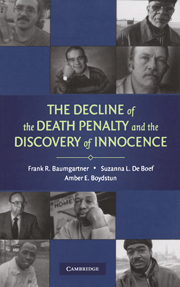Book contents
- Frontmatter
- Contents
- List of Tables
- List of Figures
- Acknowledgments
- 1 Innocence and the Death Penalty Debate
- 2 The Death Penalty in America
- 3 A Chronology of Innocence
- 4 The Shifting Terms of Debate
- 5 Innocence, Resonance, and Old Arguments Made New Again
- 6 Public Opinion
- 7 The Rise and Fall of a Public Policy
- 8 Conclusion
- Epilogue: Individuals Exonerated from Death Row
- Appendix A New York Times capital punishment coverage, 1960 to 2005
- Appendix B Description of Data
- Notes
- References
- Index
7 - The Rise and Fall of a Public Policy
Published online by Cambridge University Press: 05 September 2012
- Frontmatter
- Contents
- List of Tables
- List of Figures
- Acknowledgments
- 1 Innocence and the Death Penalty Debate
- 2 The Death Penalty in America
- 3 A Chronology of Innocence
- 4 The Shifting Terms of Debate
- 5 Innocence, Resonance, and Old Arguments Made New Again
- 6 Public Opinion
- 7 The Rise and Fall of a Public Policy
- 8 Conclusion
- Epilogue: Individuals Exonerated from Death Row
- Appendix A New York Times capital punishment coverage, 1960 to 2005
- Appendix B Description of Data
- Notes
- References
- Index
Summary
In chapter 6, we demonstrate powerful framing effects on aggregate public opinion – specifically, how the innocence frame led to a slow but steady and cumulatively important decrease in public support for the death penalty over the last decade. In that chapter, our focus is fine-grained; we use quarterly data to measure short- as well as long-term opinion responsiveness to the shifting foci of media attention. In doing so, we eliminate counterexplanations for the decline in death penalty support that we have observed since the mid-1990s; in particular, neither executions nor exonerations help to explain this change. Homicides and the cascade of attention paid to the new innocence frame together explain the decline in support for the death penalty. The changes in public opinion that we note in Chapter 6 are not spectacular; many people continue to view the death penalty in the same way they always have. All members of the public have not been affected by the innocence frame, and the survey questions about the topic tend to elicit, we think, relatively general or generic reactions to the issue. We will see here that public policy and the behaviors of juries have been much more greatly affected by the innocence frame than aggregate public opinion. Further, even the modest shifts in public opinion that we document in Chapter 6 have a powerful impact on public policy. In this sense, public opinion itself contributes to the positive feedback mechanisms that are at the heart of an attention cascade.
- Type
- Chapter
- Information
- The Decline of the Death Penalty and the Discovery of Innocence , pp. 200 - 215Publisher: Cambridge University PressPrint publication year: 2008



